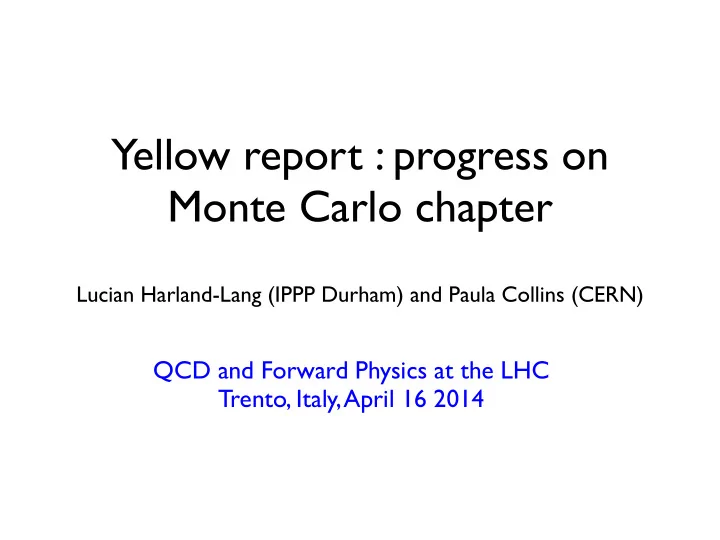

Yellow report : progress on Monte Carlo chapter Lucian Harland-Lang (IPPP Durham) and Paula Collins (CERN) QCD and Forward Physics at the LHC Trento, Italy, April 16 2014
Aims • Slightly different emphasis to later chapters, i.e. focus more on introduction than outlook. • Main aim of chapter is to describe the MCs used in later chapters (so this does not have to be repeated) : ‣ Processes (diffractive and forward physics) generated. ‣ Approximations/limitations in the underlying models and implementation. ‣ Discussion of uncertainties. ‣ Outlook : what future work is planned (if any)? Theoretical improvements to be included? Further tuning needed? What future LHC data would be most useful for this? ‣ ...?
Contributions • Idea is to have an individual section for each MC, with a contribution covering these topics from one of the authors. Some contributions are confirmed, aim to have more confirmations very soon. • MCs to be included so far (see yellow report plan) : ‣ Pythia - Peter Skands ‣ Herwig++ - tbc ‣ Phojet - Ralph Engel (Anatoli Fedynitch- resumed development) ‣ FPMC - Oldrich Kepka, Christophe Royon, Matthias Saimpert ‣ Exhume - tbc ‣ Superchic + Dime - LHL, Valery Khoze ‣ EPOS - Tanguy Pierog ‣ QGSJETII - Sergey Ostapchenko ‣ Others??
Other topic to cover (?) : MC comparison • As well as describing each MC individually, it would be useful to show some comparison plots for ‘benchmark’ forward physics processes. • Consider distributions in kinematic variables of interest, for same event selection, for a range of MCs/tunes... ATLAS forward rapidity gap cross section Herwig++ EPOS, PHOJET, MBR PYTHIA 7000 GeV pp 7000 GeV pp 7000 GeV pp Soft QCD (mb,diff,fwd) Soft QCD (mb,diff,fwd) Soft QCD (mb,diff,fwd) [mb] [mb] [mb] 1.9M events 200k events 200k events ! ! ! Rapidity gap size (pT > 0.2, | | < 4.9) Rapidity gap size (pT > 0.2, | | < 4.9) Rapidity gap size (pT > 0.2, | | < 4.9) # ! # ! # ! d d d d d d ATLAS ATLAS ATLAS 2 2 2 10 10 10 Epos (LHC re-tune) $ Epos (LHC re-tune) $ D6T $ Rivet 1.8.2, Rivet 1.8.2, Rivet 1.8.2, Phojet Herwig++ Pythia 6 (103:DW) Pythia 8 Herwig++ (UE-EE-4-CTEQ6L1) Pythia 6 (320:P0) Pythia 8 (MBR) Phojet Pythia 6 (343:Z2) Pythia 8 Pythia 8 (MBR) Sherpa Pythia 8 (Tune 2M) 10 Pythia 8 (Tune 4C) 10 10 1 mcplots.cern.ch mcplots.cern.ch mcplots.cern.ch 1 1 ATLAS_2012_I1084540 ATLAS_2012_I1084540 ATLAS_2012_I1084540 -1 10 Epos 1.99.crmc.v3400, Phojet 1.12a, Pythia 8.170 Epos 1.99.crmc.v3400, Herwig++ 2.6.1a, Phojet 1.12a, Pythia 8.165, Sherpa 1.4.0 Pythia 6.425, Pythia 8.170 0 2 4 6 8 0 2 4 6 8 0 2 4 6 8 " ! " ! " ! F F F Taken from Sercan Sen’s talk ‘LHC forward analyses: MC study’ at Calabria meeting
Other topics to cover (?) : MC comparison Inclusive production of netrual pions at y > 8.9. 7000 GeV pp 7000 GeV pp Soft QCD (mb,diff,fwd) Soft QCD (mb,diff,fwd) ] 200k events ] 200k events 1 -2 -2 [GeV [GeV # # 0 0 pT( ) (9.2 < |y| < 9.4, p < 0.6 GeV/c) pT( ) (9.6 < |y| < 10.0, p < 0.6 GeV/c) T T 1 3 3 LHCF LHCF /dp /dp Epos " Epos " Rivet 1.8.2, Rivet 1.8.2, -1 10 ! ! Epos (LHC re-tune) Epos (LHC re-tune) 3 3 E d E d Phojet Phojet -1 10 Pythia 8 (Tune 4C) Pythia 8 (Tune 4C) inel inel ! ! 1/ 1/ -2 10 -2 10 -3 10 es, -3 10 9.2 < y < 9.4 9.6 < y < 10.0 mcplots.cern.ch mcplots.cern.ch -4 10 -4 10 LHCF_2012_I1115479 LHCF_2012_I1115479 Epos 1.99.crmc.v3400, Phojet 1.12a, Pythia 8.170 Epos 1.99.crmc.v3400, Phojet 1.12a, Pythia 8.170 0 0.2 0.4 0.6 0 0.1 0.2 0.3 0.4 p [GeV] p [GeV] T T Taken from Sercan Sen’s talk ‘LHC forward analyses: MC study’ at Calabria meeting • Plots shown here compare with existing data. Perhaps more sensible in the report to consider predictions for future LHC data. • To do : decide on benchmark processes to consider. Volunteer needed to perform this analysis! Suggestions welcome...
Summary and Outlook • Aim is to produce a mostly introductory chapter, with individual sections describing the MCs on the market (processes generated, limitations/ uncertainties, future work/tuning, useful future data...). • In addition (?), a direct comparison of the MC predictions for some selected ‘benchmark’ forward physics processes. Demonstrate how future LHC data may discriminate between the different underlying models provide better → understanding of forward direction. Need to decide on processes to consider, and volunteer needed for analysis. • Suggestions for other topics of discussion are welcome...
Recommend
More recommend